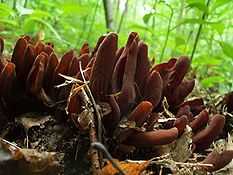Wynnea
| Wynnea | |
|---|---|
 | |
| Wynnea americana | |
| Scientific classification | |
| Kingdom: | Fungi |
| Division: | Ascomycota |
| Subdivision: | Pezizomycotina |
| Class: | Pezizomycetes |
| Order: | Pezizales |
| Family: | Sarcoscyphaceae |
| Genus: | Wynnea Berk. & M.A. Curtis |
| Type species | |
| Wynnea gigantea Berk. & M.A. Curtis | |
| Species | |
|
W. americana | |
Wynnea is a genus of fungi in the Sarcoscyphaceae family of cup-fungi. First described by English naturalist Miles Joseph Berkeley in 1866, the genus contains eight species that have ear-shaped fruiting bodies that grow on the ground. Wynnea species have a worldwide distribution and have been collected from the United States, Costa Rica, India, and China.
Taxonomy
The genus Wynnea was first described by English naturalist Miles Joseph Berkeley in 1866 to accommodate the species Wynnea gigantea and Peziza macrotis.[1] The former specimen was collected by Botteri near Orizaba, Mexico, and the latter had been described by Berkeley in his Journal of Botany and Kew Garden Miscellany (1851)[2] Both species were subsequently illustrated in Cooke's Micrographia. No other collections of Wynnea were reported for several decades, and in Pier Andrea Saccardo's Sylloge, the genus was reduced to synonymy with the genus Midotis. American mycologist Roland Thaxter described a new species in 1905, W. americana, which was collected in Tennessee.
Description
The fruiting bodies (technically called apothecia) are thick, firm, tough and become almost leathery after drying. Standing erect, the ear-shaped apothecia are several- to many-clustered on a common stalk that arises from a sclerotium, a hardened mass of mycelium buried in the earth. The paraphyses (sterile cells interspersed amongst the asci) are cylindrical, simple or branched. The spore-producing structures, the asci, are cylindrical, and taper to an elongated base that penetrate to underneath the hymenium.[2]
Like other members of the Sarcoscyphaceae family, Wynnea species have multinucleate ascospores and paraphyses. The ascus has a thickened apical ring capped by a hinged operculum; its opening often is oriented obliquely, a condition referred to as suboperculate.[3] Three structural components are involved in spore discharge in Wynnea species: the operculum, the suboperculum, and the zone of dehiscence. Collectively, these three structures are known as the apical apparatus.[4]
Distribution
Wynnea species have a worldwide distribution.[5] They have been collected from several North American locations; in the United States, they have been found in Tennessee, New York, West Virginia, North Carolina, Ohio, and Pennsylvania.[6][7][8] Wynnea species have also been collected in Costa Rica,[9] and India.[10] W. macrospora and W. sinensis are found in Guizhou Province, China.[11]
Species

There are eight species described in the genus Wynnea:
- W. americana[2]
- W. frominda[12]
- W. gigantea
- W. intermedia
- W. macrospora[11]
- W. mactrotis
- The spoon-shaped apothecia originate from a fleshy, brown, underground sclerotium; the external surface color is brown when fresh, and dark brown on drying; the height may reach 5 to 8 centimetres (2.0 to 3.1 in). This is one of the original Wynnea species, and was first named Peziza macrotitis when first described in 1851, later named Wynnea macrotis by Berkeley, and then again to Midotis macrotis by Saccardo in 1889. It was collected again in India (West Bengal) and redescribed in 1969.[13]
- W. sinensis[11]
- W. sparassoides
- This species has a roughly oval head that is 6 to 8 centimetres (2.4 to 3.1 in) wide connected to a stipe that is up to 30 centimetres (11.8 in) long by 2–2.5 centimetres (0.8–1.0 in) wide.[14]
References
- ↑ Berkeley, J. Linn. Soc., Bot. 9: 424 (1867)
- ↑ 2.0 2.1 2.2 Thaxter R., Roland (1905). "A new American species of Wynnea". Botanical Gazette 39 (4): 241–47. doi:10.1086/328614.
- ↑ Alexopoulos CJ, Mims CW, Blackwell M. (1996). Introductory Mycology. New York: Wiley. p. 416. ISBN 0-471-52229-5.
- ↑ Samuelson DA., Don A. (1975). "Apical apparatus of suboperculate ascus". Canadian Journal of Botany 53 (22): 2660–79. doi:10.1139/b75-295.
- ↑ Aneja KR. (1990). An Introduction to Mycology. Columbia, Mo: South Asia Books. p. 377. ISBN 81-224-0089-2. Google Books
- ↑ Overholts, L. O. (1924). "Mycological notes for 1921–22". Mycologia 16 (5): 233–39. doi:10.2307/3753263. JSTOR 3753263. Retrieved 10 October 2013.
- ↑ Henry L.K. (1943). "Wynnea americana in western Pennsylvania". Mycologia 35: 131–32.
- ↑ Korf, Richard P. (1949). "Wynnea americana". Mycologia 41 (6): 649–51. doi:10.2307/3755021. JSTOR 3755021.
- ↑ Pfister, D.H.; Gómez-Pignataro; Luis Diego (1978). "On a collection of Wynnea americana new record from Costa Rica with some comments on the distribution and delimitation of Wynnea species in the neotropics". Brenesia. 14–15: 395–400.
- ↑ Batra LR, Batra SWT. (1963). "Indian Discomycetes". University of Kansas Science Bulletin 44 (1/14): 109–256.
- ↑ 11.0 11.1 11.2 Liu B, Cao J-Z, Liu M-H. (1987). "Two new species of the genus Wynnea from China with a key to known species". Mycotaxon 30: 465–71.
- ↑ Waraitch KS., K.S. (1976). "New species of Aleuria and Wynnea fromindia". Transactions of the British Mycological Society 67 (3): 533–36. doi:10.1016/S0007-1536(76)80192-1.
- ↑ Kar AK, Pal KP., A.K.; Pal, K.P. (1969). "The Pezizales of Eastern India". Canadian Journal of Botany 48 (1): 145–46. doi:10.1139/b70-019.
- ↑ Miller HR, Miller OK. (2006). North American Mushrooms: a Field Guide to Edible and Inedible Fungi. Guilford, Conn: Falcon Guide. p. 533. ISBN 0-7627-3109-5. Google Books
External links
- Wynnea in Index Fungorum.